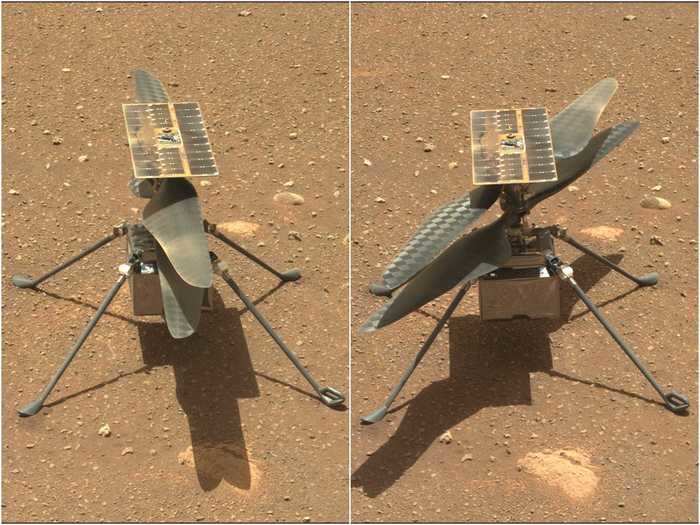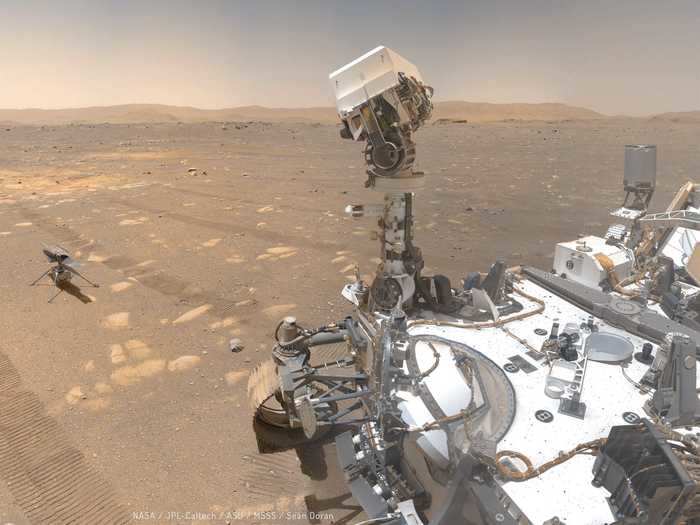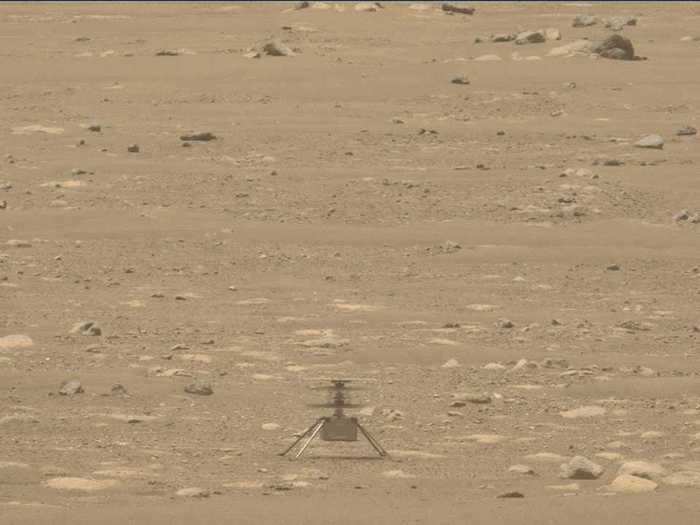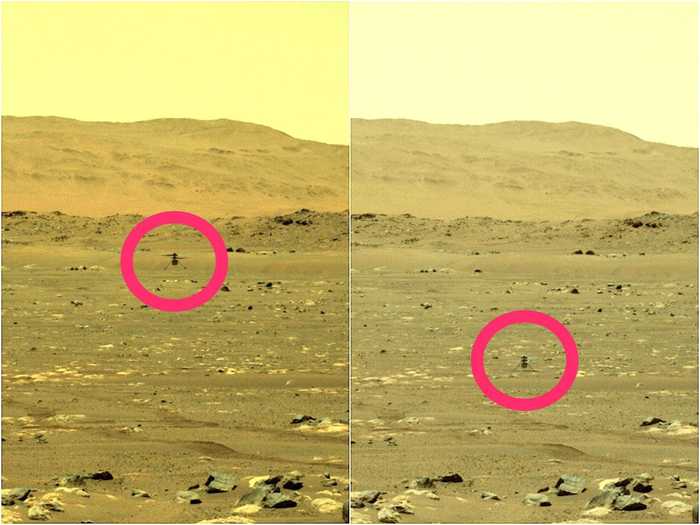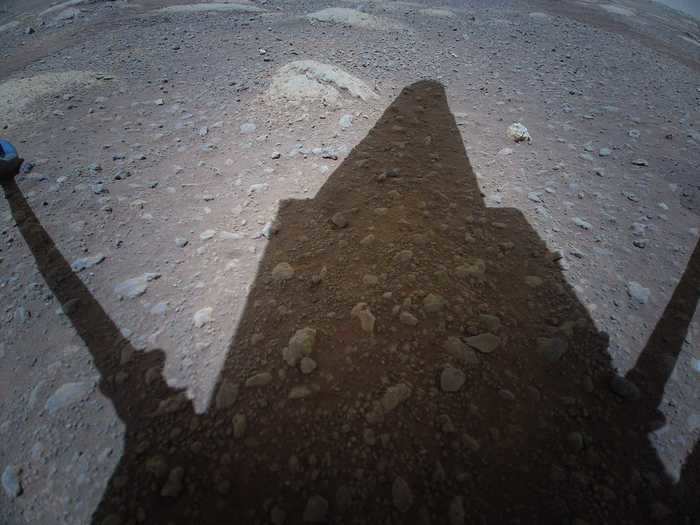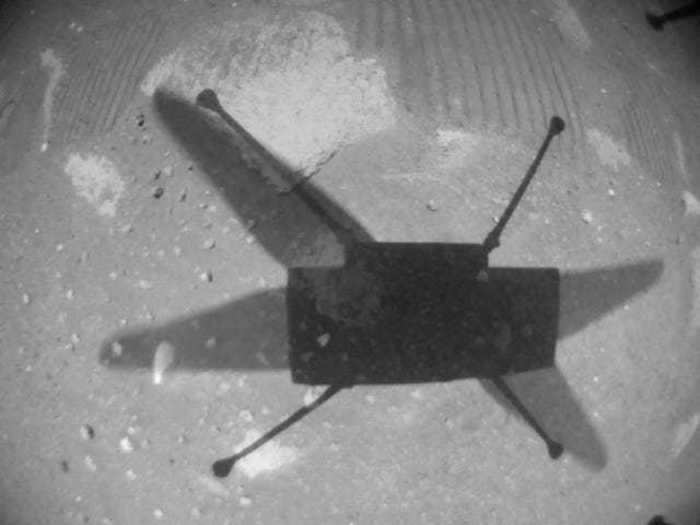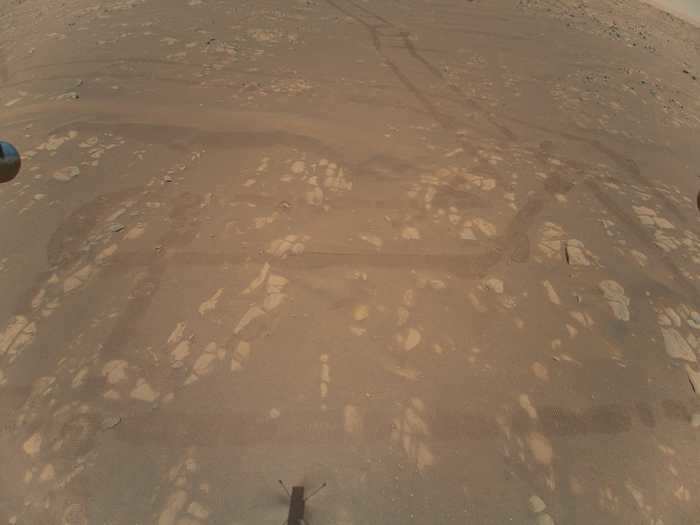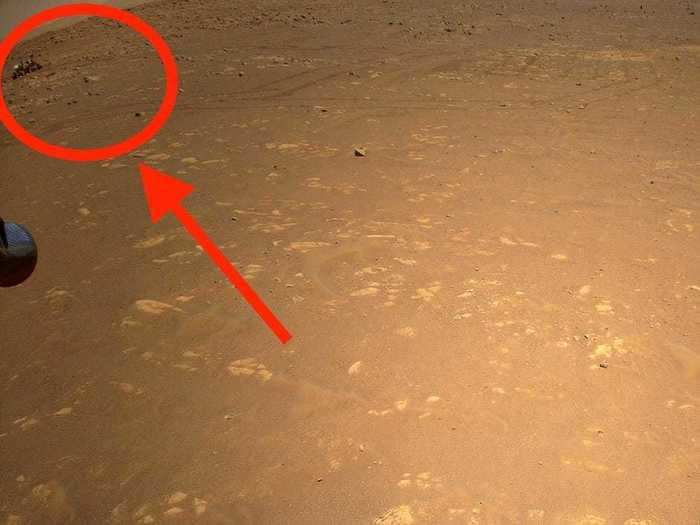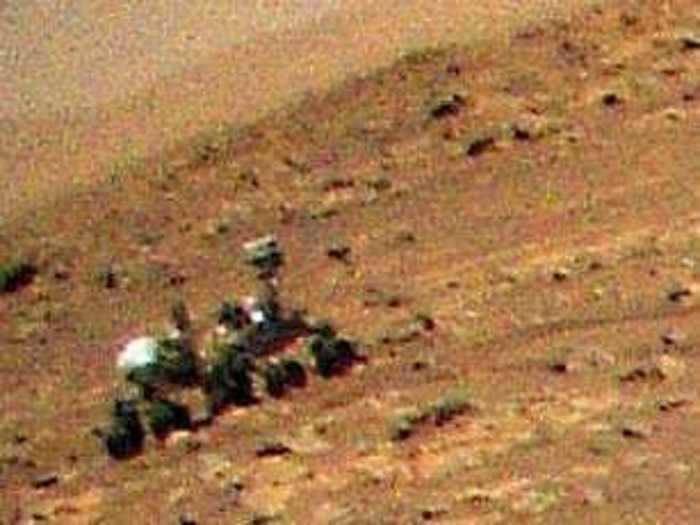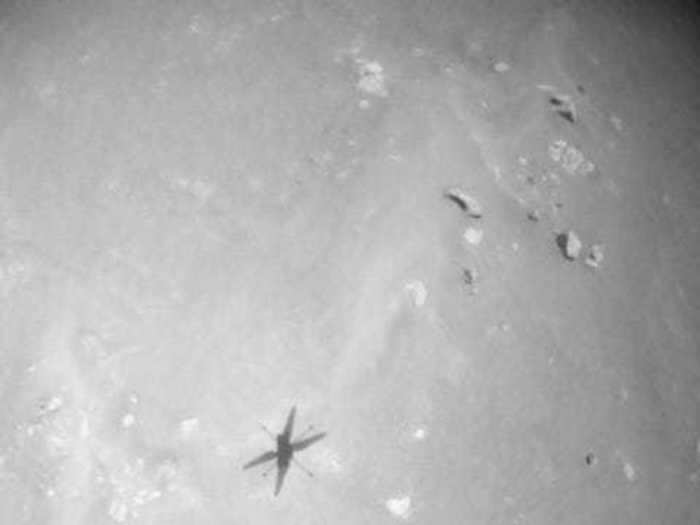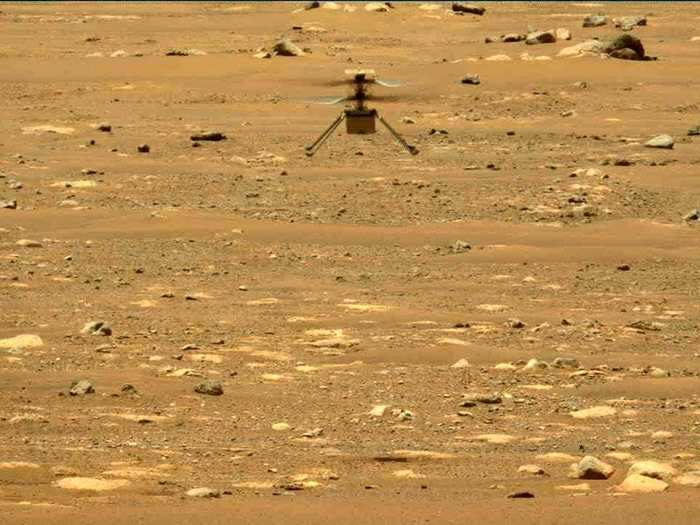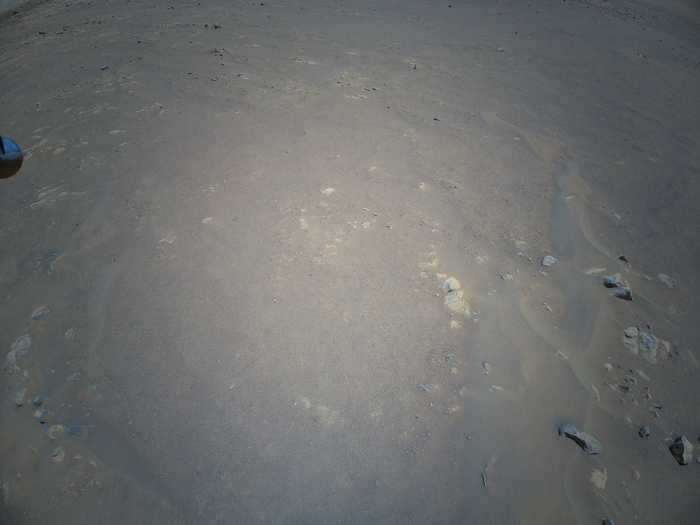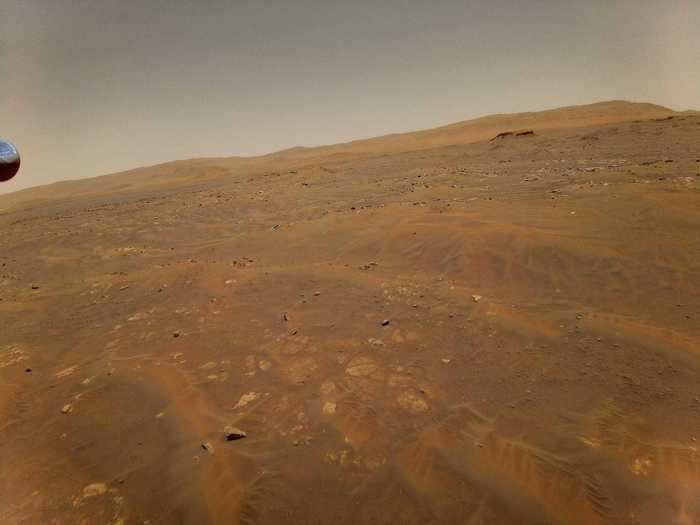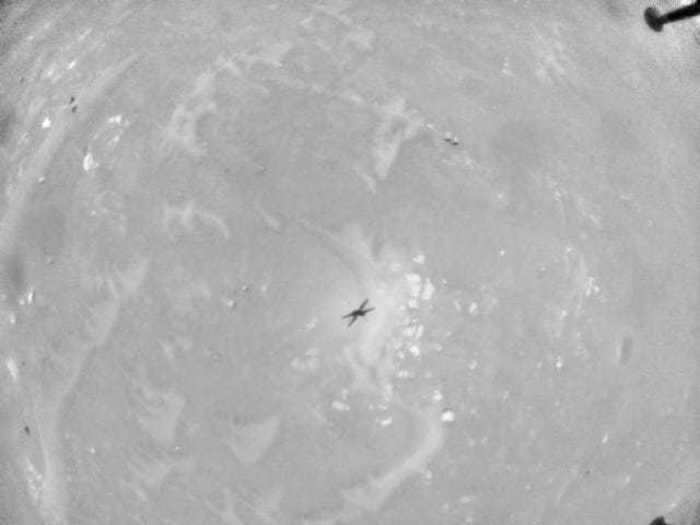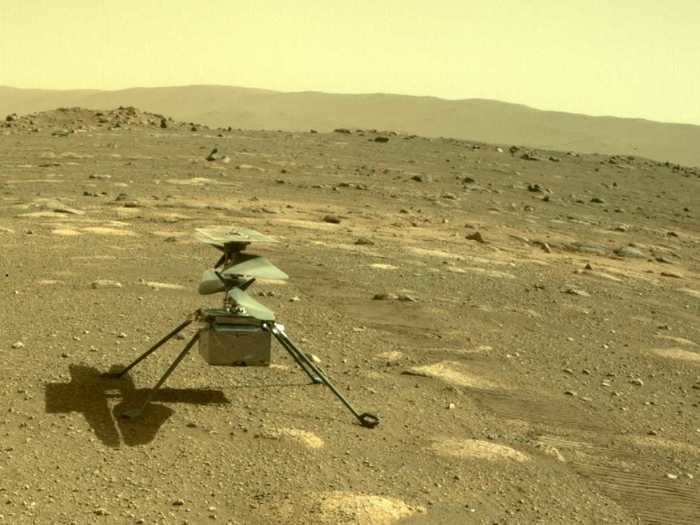On Monday, NASA's Ingenuity helicopter completed its eighth flight on Mars.
The Perseverance rover captured the Ingenuity helicopter before (left) and after (right) spinning its rotor blades.
NASA/JPL-Caltech/ASU
The 4-pound helicopter spun its two pairs of blades to lift itself more than 30 feet above the ochre Martian dust. At a speed of 9 mph, it zipped to a new landing spot 525 feet away.
The tissue-box-sized space drone has come a long way since the Perseverance rover dropped it onto the Martian surface in April.
The Perseverance rover took a selfie with Ingenuity before its first flight in April.
NASA/JPL-Caltech/MSSS/Seán Doran
The pair of robots landed in Mars' Jezero Crater on February 18.
Ingenuity was meant to conduct up to five test flights in order to prove that helicopters could fly over and explore Mars. The demo chopper has far exceeded engineers' expectations.
Ingenuity made history on April 19 when it took flight for the first time. It hovered 10 feet above the Martian surface for about 30 seconds.
Mastcam-Z, an imager aboard the Perseverance rover, captured Ingenuity taking off and landing for its first flight on April 19, 2021.
NASA/JPL-Caltech/ASU/MSSS
It was the first powered, controlled flight ever conducted on another planet.
A camera on the Perseverance rover captured the flight in exquisite color.
The Perseverance rover captured Ingenuity's first flight on Mars, April 19, 2021.
NASA/JPL-Caltech
Perseverance moved to a nearby overlook to photograph and film the event.
Ingenuity snapped its own photos, too, using a color camera on the bottom of the helicopter.
Ingenuity photographed its own shadow on April 9, 2021.
NASA/JPL-Caltech
The camera is mounted on Ingenuity's fuselage, and it points about 22 degrees below the horizon. That allows the lens to capture some of the Martian landscape in the distance as Ingenuity flies.
A black-and-white navigation camera also captures images as the chopper flies.
Ingenuity photographed its own shadow just above the Martian surface - along with some tracks from the Perseverance rover - during its third flight, April 25, 2021.
NASA/JPL-Caltech
That camera points straight down, allowing the helicopter to map where it is above the Martian surface.
Ingenuity's color camera captured mid-flight photos of Perseverance's tracks in the dust below.
Ingenuity photographed Perseverance's tracks, and its own shadow, during its second flight, April 22, 2021.
NASA/JPL-Caltech
The photo above is the first color image taken from an aerial vehicle flying on Mars.
The camera even spotted Perseverance during Ingenuity's third flight.
NASA's Perseverance rover is visible in the upper-left corner of this image from Ingenuity's third flight on Mars, April 25, 2021.
NASA/JPL-Caltech
During that flight, Ingenuity zipped about 160 feet down its flight zone, then returned, at 4.5 mph.
Perseverance watched Ingenuity's first five flights, then drove away to start on its own science mission: searching for signs of ancient alien life.
A zoomed-in view of Perseverance from the photo Ingenuity captured during its third flight.
NASA/JPL-Caltech
Perseverance is now exploring the deposits left behind by a lake that once filled Jezero Crater. Scientists think that this lake may have hosted microbial life 3.5 billion years ago. Sediment falling to the lake bottom may have trapped and fossilized some of those microbes — if they existed.
Perseverance aims to collect dozens of soil samples from the lake bed, the nearby river delta, and the shorelines. It will stash those samples for a future mission to carry back to Earth.
Meanwhile, Ingenuity's navigation camera snapped photos throughout each flight, which combine to offer stop-motion-style footage of its shadow traveling over Martian ground.
NASA's Ingenuity Helicopter took these images on its fourth Mars flight, on April 30, 2021, using its black-and-white navigation camera.
NASA/JPL-Caltech
"Goosebumps — it looks just the way we had tested," MiMi Aung, the Ingenuity project manager, said as she presented video of Ingenuity's first flight at a press conference in April. "Absolutely beautiful flight — I don't think I can ever stop watching it over and over again."
Ingenuity carried out its first three flights so flawlessly that NASA gave it a new, extended mission.
NASA's Ingenuity helicopter mid-air on April 22, 2021.
NASA/JPL-Caltech/ASU/MSSS
For as long as it survives, the Ingenuity team decided, the helicopter will keep flying to new airfields. That way, it can test operations that NASA might want to conduct with future space helicopters. That includes scouting and mapping, observing interesting features of Mars from the air, and exploring rough terrain that rovers can't access.
Over eight flights, the helicopter has pushed itself further, faster, and higher. It has landed safely in uncharted territory three times.
Ingenuity's color camera captured the ground below in sharp detail during a flight on May 7, 2021.
NASA/JPL-Caltech
NASA engineers initially did not think they could fly Ingenuity higher than 16 feet, but the helicopter has reached heights of about 33 feet. It's traveled as far as 873 feet in a single flight and moved as fast as 9 mph.
It's hopped to four new airfields — three of which were unsurveyed.
Ingenuity even survived a mid-air error. During its sixth flight, a glitch made the helicopter tilt wildly back and forth.
Ingenuity took this image of Mars from 33 feet in the air during its sixth flight, May 22, 2021.
NASA/JPL-Caltech
About 54 seconds into the flight, a small glitch occured as the navigation camera sent images to the helicopter's computer. The chopper lost just one image, but that meant that each following photo was delivered with the wrong timestamp.
The error made Ingenuity roll and pitch, leaning more than 20 degrees from one side to the other. But it still managed to land safely.
This sequence of images - taken on May 22, 2021 by Ingenuity's navigation camera - depicts the last 29 seconds of the rotorcraft’s sixth flight, when it began tilting back and forth.
NASA/JPL-Caltech
"While we did not intentionally plan such a stressful flight, NASA now has flight data probing the outer reaches of the helicopter's performance envelope," Håvard Grip, Ingenuity's chief pilot, wrote in a blog update on the incident.
NASA expected Ingenuity to crash long ago, but it still has more flights ahead.
NASA’s Ingenuity helicopter, photographed on Mars by the Perseverance rover’s rear Hazard Camera on April 4, 2021.
NASA/JPL-Caltech
Perseverance scientist Ken Farley told a NASA group on Monday that he expects Ingenuity's new mission to continue for a few more months, according to SpaceNews reporter Jeff Foust.
That would keep up the current rate of about two flights per month. In the future, more advanced helicopters may even work alongside astronauts on Mars.

